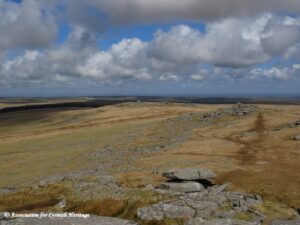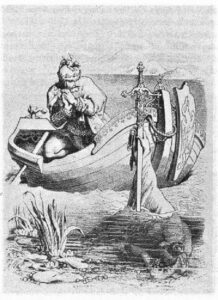Dozmary Pool landscape and legend entwined
Dozmary Pool was a lockdown visit earlier this year which started with some wonderful weather and throughout there was lots to do outside. This coming month will be a little different, but hopefully weather permitting there will be time to get out and explore some more of Cornwall.
An enjoyable aspect of writing articles for the Voice newspapers is browsing through books searching for information to share. This week, I thought I’d start looking at what was being said about Cornwall over 100 years ago. A place that stood out to be worth a visit was the legendary Dozmary Pool on Bodmin Moor that has been much written about.

In Highways & Byways in Devon & Cornwall by Arthur H Norway first published in 1897 Arthur travelled around Cornwall visiting towns, villages and spots of interest and included many stories, legends and myths into his writing. He wrote about his visit to Bodmin Moor, just a little about Dozmary Pool and a great deal about its alleged connection with King Arthur.
Of Bodmin Moor he writes. “They are bare and lonely, it is true, but on a gusty day the play of light and shade on their slopes is glorious ; and in hot weather there are rich purples in the hollows which mount upwards as the sun sinks till they cover all the hills. There are fine outlines, too, when the highest point of the road is reached, and the great crag of Rough Tor is seen breaking the skyline with its jagged crest, while beside it the sister peak of Brown Willie rears a summit which is rounded and less impressive, but equally associated in the wild traditions of the spot. These two mountains are the most conspicuous in Cornwall. From far and near their twin peaks are visible bathed in brilliant sunlight or glowing in the evening with rose and purple. In a country of greater elevations they would hardly catch the eye; but here no higher eminences draw off attention from them, and it is not difficult to understand how suitable the simple minds of early dwellers in the west thought their rugged slopes both for their own but dwellings and for those sacred monuments which, were spoken of at length in the last chapter.”
Of Dozmary Pool. “At a little distance away across the moors lies the only inland lake in Cornwall, a lonely tarn on an elevated plateau among the hills, and insignificant as it may be, regarded as a lake, it is in association the most famous ground in England, if there be any faith in Sir Thomas Malory at all. For this is doubtless that lake to which Merlin and King Arthur rode, when the King had fought with Pellinore, and been sore hurt and lost his sword; and in the midst of the lake " Arthur was ware of an arm clothed in white samite, that held a fair sword in its hand. ' Lo,' said Merlin, `yonder is that sword I spake of.' So Sir Arthur and Merlin alight, and tied their horses to two trees, and so they went into the ship, and when they came to the sword that the hand held Sir Arthur took it up by the handles, and took it with him, and the arm and the hand went under the water.”
Norway then gives a graphic account of Excalibur’s return to the lake by Sir Bedivere and follows it with the legend of Tregeagle. “It is of Tregeagle that the peasants talk when Dozmare is mentioned; it is him they fear when the winter twilight darkens down among the hills, and the storm wind runs wailing up the valleys. For on such nights the moormen cowering in their cottages hear a great voice above the whistle of the tempest and the lashing of the rain upon their windows, a sound of human pain and anguish, the bellowing of one in mortal fear ; and as that terrifying voice reverberates and spreads down into the lower country, many a cottage door is barred more tightly, and the mothers call their children to their side, for they know well that the cries are uttered by Tregeagle, whose soul is lost for ever if he pause in his penance of baling Dozmary dry with a single limpet shell.”
The Reverend J.J. Daniel in his ‘Geography of Cornwall’ published in 1854 is somewhat more factual, omits Arthur but includes Tregeagle and tells us. “Dozmary Pool is a tarn or mountain-lake, 890 feet above the sea level, in the north part of the moors of St. Neot. From the lifeless character of its waters it has been called the Dead Sea of Cornwall. It is about a mile round, nearly circular and is from twelve to eighteen feet deep. This, as the fable runs, is the scene of Tregeagle's punishment; he is doomed to dip out Dozmary Pool with a limpet shell. Other idle tales of this dreaded pool are that it is bottomless; that it ebbs and flows with the tide; that there is a whirlpool in the middle, which swallows faggots and disgorges them into the sea at Fowey. It contains eels and large trout.”
Likewise, many travel writers such as Cyrus Redding in his 1842 ‘An Illustrated Itinerary of the County of Cornwall’ makes no mention of Arthur. Redding is scathing about Dozmary Pool and must have visited on a bad day he writes. “The great mail road disappeared by a turn among the moors, up which we proceeded to visit the celebrated lake, or rather tarn, called Dosmary Pool No scene can be imagined more horribly dreary. In most mountainous countries, bare of vegetation, a peak, a rock, a precipice, the mere wreck of something, besides a lifeless tarn, is in the scene, relieves the eye, and breaks the sameness of the view. Nothing of the kind was observable here. Dosmary is a piece of water at the bottom of two or three rounded eminences, covered with stunted heath, in itself dark and unlovely enough. It is contemptible as a lake, not being more than a mile in circumference, yet its extraordinary desolation attaches to it a species of singularity that strikes from its very negation of all character. The cheerless aspect of the spot naturally accounts for the stories which the country people have invented, of its unfathomable depth, it is really shallow and of its extraordinary visitant. When the winter winds sweep over the hills around, and ruffle at such times the almost leaden stillness of its surface; when the misty rain dims the landscape, or the sound of the tempest almost. stuns the ear, the Cornish cry, "Tregagle is roaring; hark!"
The reason that Daniel and Redding made no reference to King Arthur and Dozmere was that it was an invention of the Poet Laureate Alfred Lord Tennyson who along with his friend R S Hawker, of ‘Trelawny’ fame, were ardent Arthurian writers and poets. Tennyson’s ‘Idylls of the King’ wasn’t published until after 1859 and the popular thought of linking Dozmary to Arthur was implanted by him, taking hold and perpetuated to this day.
On a pleasant day Dozmary Pool and surrounding moorland is an interesting and beautiful place to visit. It is a not overly large post glacial lake with a surface area of just 37 acres and a maximum of 9’ deep. It has no visible source of water and overflows into the much larger Colliford Lake reservoir. Legendary claims that Dozmary Pool is bottomless, was discounted by both Cyrus Redding and Reverend Daniel and during the droughts in 1859 and 1976 it dried out to show a shallow lakebed. In 1951 it was designated a Site of Special Scientific Interest and travel guide Lonely Planet describe it as a “mysterious and atmospheric place.” As for Excalibur a 4’ sword was found by a young girl in 2017 but was only a few decades old and deemed a film prop or a hoax.






![Dozmary Pool [4] Dozmary Pool, Bodmin Moor](https://www.cornwallheritage.com/wp-content/uploads/2020/11/Dozmary-Pool-4-300x164.jpg)

![Dozmary Pool [2] Dozmary Pool, Bodmin Moor](https://www.cornwallheritage.com/wp-content/uploads/2020/11/Dozmary-Pool-2-300x163.jpg)
![[20] Voice - Ertach Kernow-111120A - Landscape and legend entwined [S] Ertach Kernow - Landscape and legend entwined at Dozmary Pool](https://www.cornwallheritage.com/wp-content/uploads/2020/11/20-Voice-Ertach-Kernow-111120A-Landscape-Legend-S-232x300.jpg)
![[20] Voice - Ertach Kernow-111120B - Landscape & Legend [S] Ertach Kernow - Landscape and legend entwined](https://www.cornwallheritage.com/wp-content/uploads/2020/11/20-Voice-Ertach-Kernow-111120B-Landscape-Legend-S-234x300.jpg)